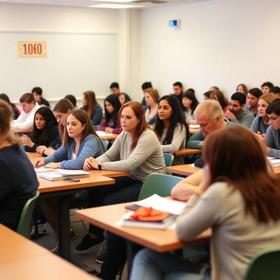- The mission of Imperial Valley College is to foster excellence in education that challenges students of every background to develop their intellect, character, and abilities; to assist students in achieving their educational and career goals; and to be responsive to the greater community.
School Highlights
Imperial Valley College serves 10,716 students (36% of students are full-time).
The college's student-teacher ratio of 27:1 is lower than the state community college average of 32:1.
Minority enrollment is 94% of the student body (majority Hispanic), which is more than the state average of 77%.
Quick Facts (2026)
- Enrollment: 10,716 students
- In-state tuition: $1,365
- Out-state tuition: $7,525
- Student-teacher ratio: 27:1
- Minority enrollment: 94%
- Source: Integrated Postsecondary Education Data System (IPEDS)
Top Rankings
Imperial Valley College ranks among the top 20% of public schools in California for:
Category
Attribute
School Overview
The teacher population of 401 teachers has stayed relatively flat over five years.
Imperial Valley College
(CA) Community College Avg.
Carnegie Classification
Associate's Colleges: High Transfer-High Traditional
Baccalaureate/Associate's Colleges: Associate's Dominant
Institution Level
At least 2 but less than 4 years
At least 2 but less than 4 years
Institution Control
Public
Public
Total Faculty
401 staff
315 staff
School Calendar
Student Body
The student population of Imperial Valley College has grown by 50% over five years.
The student-teacher ratio of 27:1 has decreased from 39:1 over five years.
The Imperial Valley College diversity score of 0.20 is less than the state average of 0.70. The school's diversity has grown by 17% over five years.
Total Enrollment
10,716 students
9,796 students
Student-Teacher Ratio
27:1
32:1
# Full-Time Students
3,849 students
1,259 students
# Part-Time Students
6,867 students
8,537 students
# Enrollment Undergraduate
107 students
242 students
# Full-Time Undergraduate Students
3,849 students
1,250 students
# Full-Time Graduate Students
n/a
63 students
# Part-Time Undergraduate Students
6,867 students
8,299 students
# Part-Time Graduate Students
n/a
10 students
Total Dormitory Capacity
n/a
121 students
% American Indian/Alaskan
n/a
n/a
% Asian
1%
13%
% Hispanic
89%
47%
% Black
1%
7%
% White
6%
23%
% Hawaiian
n/a
1%
% Two or more races
1%
5%
% Non Resident races
n/a
1%
% Unknown races
2%
3%
Diversity Score
0.20
0.70
College Completion Rate (Students who graduate in less than 4 years)
37%
42%
College Completion Rate (Students who graduate in 4 years or more than 4 years)
n/a
43%
Average Graduate Earnings (10 Years)
$29,500
$34,700
Tuition and Acceptance Rate
The public in-state tuition of $1,365 is less than the state average of $1,516. The in-state tuition has grown by 18% over four years.
The public out-state tuition of $7,525 is more than the state average of $6,779. The out-state tuition has grown by 24% over four years.
In-State Tuition Fees
$1,365
$1,516
Out-State Tuition Fees
$7,525
$6,779
% Students Receiving Some Financial Aid
94%
85%
Median Debt for Graduates
n/a
$10,500
Median Debt for Dropouts
n/a
$6,239
Acceptance Rate
n/a
93%
Source: 2024 (or latest year available) Integrated Postsecondary Education Data System (IPEDS)
School Notes
- Imperial Valley College is part of the Imperial Community College District. Its boundaries encompass seven high school districts that serve Imperial County residents. The high school districts are Calexico Unified, Central Union, Holtville Unified, Imperial Unified, Brawley Union, Calipatria Unified and San Pasqual Unified. The original Imperial Valley College main campus, which opened in September 1962, consisted of library, science laboratories, fine arts rooms, student activities building, academic classrooms, administration and faculty offices, social science rooms, physical education shower and locker rooms, and agricultural education classrooms and shop. The Imperial Valley College campus is located on a 160-acre site at the intersection of Highway 111 and Aten Road, in Imperial, California. This location is in the heart of Imperial County and is within reasonable commuting distance of all of the cities in the Valley. There are also extended campus centers in the cities of El Centro, Brawley and Calexico. In order to meet its educational mandate, Imperial Valley College offers 900 different courses in 56 areas of study ranging from Administration of Justice to Welding Technology. The Western Association of Schools and Colleges reaccredited Imperial Valley College in 2001 for a period of six years. As one of the 71 community college districts in California, its educational mission, as defined in the state master plan for higher education and by statute, is to provide lower division transfer education, vocational and career education, and basic skills education to prepare students to succeed in college.
Frequently Asked Questions
How much does Imperial Valley College cost?
Imperial Valley College's tuition is approximately $1,365 for In-State students and $7,525 for Out-State students.
What is Imperial Valley College's ranking?
Imperial Valley College ranks among the top 20% of community college in California for: Average community college minority breakdown.
Recent Articles

Part-Time vs. Full-Time Enrollment in 2025: Which Is Better?
Explore part-time vs. full-time enrollment in 2025, comparing costs, flexibility, outcomes, and goals to help students choose the right path.

How Community Colleges Use AI Tools to Support Student Success
Explore how community colleges are using AI tools in 2025 to improve advising, learning, retention, and student success.

Nontraditional Student’s Guide to Community College 2025
Comprehensive guide for nontraditional students at community college with updated tuition, support, careers, and success strategies for 2025.









